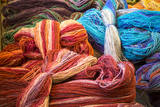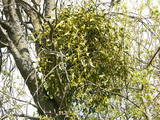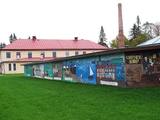| Nr | Nosaukums | Apraksts |
|---|---|---|
|
Vienīgā vieta Kurzemē, kur vēl pārstrādā vilnu un, cik zināms, tad arī vienīgā vieta Latvijā, kur veic pilnu vilnas pārstrādes procesu. Vilnas pārstrādes tradīcijas Pācē ir kopš 19.gs. beigām. Pirmās Latvijas Republikas gados te velta vadmala, bet padomju gados Pācē bija otrs lielākais sadzīves pakalpojumu sistēmas cehs Latvijā, kas pārstrādāja aitu vilnu. |
||
|
Kurtuvēnu reģionālais parks (Kurtuvėnų regioninis parkas) ir mežu, ūdeņu un mitrāju valstība. Parka reljefs ir izteikti paugurains, tādēļ tas nav ticis izmantots lauksaimniecības vajadzībām. Dabas apvidus, kurā nelielā teritorijā novērojamas daudzveidīgas reljefa formas – augsti pauguri, izteiktas upju ielejas, gravas, termokarsta piltuves, kontinentālas kāpas u.c. Te ir sastopami boreālie (ziemeļu) meži, staignāju meži un purvaini meži, sugām bagāti egļu meži, neskarti purvi, pārejas purvi un slīkšņas, avoti un avoksnāji, dažāda tipa zālāji, sausas un mitras pļavas. Kopumā parkā ir konstatētas 978 augu un 1475 dzīvnieku sugas. Kurtuvēnu apkaime ir populāra dažādu tradīciju svinēšanas vieta. Šeit atzīmē masļeņicu (iekļauta Lietuvas nemateriālā mantojuma sarakstā), vasaras un ziemas saulgriežus u.c. Kurtuvēni ir pazīstama ar zivsaimnieciskajām tradīcijām. Parka apmeklētāju centrs atrodas Kurtuvēnu muižas ratnīcā.
|
||
|
Piltenes bīskapijas laikā - 13. gs. - vidū tika uzcelta konventa tipa pils. Vēlākās pils piebūves radās 16. un 19. gs., un izveidojās tai raksturīgais iekšējais pagalms. 19. gs. 30. gados pils fasāde ieguva mūsdienās redzamās neogotiskās formas. Laikā no 16. gs. līdz 1920. g. Ēdoles pils bija baronu Bēru dzimtas īpašums. Pēc 1905. g. dedzināšanas, pili divu gadu laikā atjaunoja. Pazīstama gan ar spoku stāstiem, gan ar rūķīšu kāzām, gan ar asins traipu pils Sarkanajā istabā, kas parādījies slepkavības vietā. Lai to noslēptu, tika uzbūvēts kamīns, taču traips parādījies atkal. Pēc privatizācijas ir atjaunoti interjeri, zāles, pagrabi, kas izdekorēti ar pilij raksturīgajiem elementiem. Pils telpas un skatu tornis ir pieejams apmeklētājiem. Parkā apskatāma Mīlestības aleja un Rūķīšu ozola vieta. |
||
|
Taisa darbus (praktiskas un saimniecībā noderīgas lietas) latviešu etnogrāfiskā stilā un turpina vecās latviešu kalējmākslas tradīcijas. Apmeklētāji var izkalt naglu vai pakaviņu. |
||
|
Ar dažādām mežaudzēm klāta teritorija, kur atrodas Latvijā viena no lielākajām pusparazītauga - baltā āmuļa atradnēm. Vislabāk šie savdabīgie augi novērojami bezlapu periodā. Latvija ir Baltā āmuļa ziemeļu izplatības robeža, tāpēc tie sastopami samērā reti. Nav labiekārtota apkatei. Interesanti minēt faktu, ka daudz labāk šo augu var pamanīt un vērot ārpus lieguma teritorijas. |
||
|
Zemnieku saimniecība „Virši” audzē kaņepju sēklas, no kurām tiek iegūta kaņepju eļļa un kaņepju staks (apceptas, maltas kaņepes). ZS "Virši" produkciju ir iespējams degustēt dažādās vietās ārpus saimniecības, kā, piemēram, Kalnciema tirdziņā u.c. |
||
|
Peltsamā mūra pils tika uzcelta 13. gadsimtā. 16. gadsimtā šajā nocietinājumā atradās Livonijas karaļa Magnusa rezidence. Pils sētas pusē ir iekārtots tūrisma informācijas punkts un Peltsamā muzejs, vīna pagrabs kopā ar pārtikas muzeju, Igaunijas Mediju muzejs, galerija pART, keramikas un rokdarbu darbnīcas. Peltsamā ir izveidots brīnišķīgs rožu dārzs, ko var apskatīt gida pavadībā. |
||
|
Dendroloģiskais parks (saukts arī par Špakovska parku) dibināts 1975. g. ainaviskā vietā – t.s. Grantskalnos, kas ir Ogres Zilo kalnu turpinājums. Parkam cauri līkumo ainaviskas pastaigu takas, ir uzbūvēts skatu tornis, no kura paveras Daugavas ielejas ainava. Ainavu atdzīvina dīķis ar ūdensrozēm un Mīlētāju saliņa. Parkā aug ap 390 dažādu augu sugu un šķirņu, kā arī daži unikāli eksemplāri kā, piemēram - Amūras korķakoks Phellodendron amurense, stepes gobas Ulmus minor korķa forma u.c. Parks brīvi apmeklējams jebkurā laikā. |
||
|
Ļoti interesants zvejniecības vēstures piemineklis. Sedumi ir kādreizējās zvejas laivu piestātnes, kurās zvejnieki cēla tīklu būdas un glabāja savu inventāru. Sedumiem bija arī sociāla loma – tajos pulcējās vīri, sprieda par turpmākajiem darbiem, bet sievas un bērni taroja tīklus (lasīja zivis ārā no tīkla, kad tas pilns ar lomu). Bigauņciema sedumu tīklu būdas laika gaitā ir ieskalotas jūrā, bet Ragaciema sedumi – daļēji gājuši bojā. Lapmežciemā esošie ir vislabāk saglabājušies. Viena no tīklu būdām ir atjaunota, bet pārējās atrodas ļoti sliktā stāvoklī. Tas varbūt ir arī iemesls, kādēļ, ejot gar jūras krastu, tām ir jāpievērš uzmanība un jāuztaisa kāda „vēsturiska" foto. |
||
|
Pirmā radiolokācijas stacija Dņestr – M darbību uzsāka 1969. g. Ar tās palīdzību varēja aprēķināt palaistas ballistiskās raķetes trajektoriju. Te izsekoja arī kosmisko pavadoņu trajektorijas. Stacijas darbības attālums bija 5000 km. Netālu no tās 1972. g. uzsāka otra – modernāka "ātrās atklāšanas" kompleksa Dņepr – M. būvniecību. 1977. g. tas bija kaujas gatavībā. Vienlaikus modernizēja arī pirmo. Abu staciju komplekss sastāvēja no divām ēkām 250 m garumā un 17 m augstumā. Diennaktī tas varēja nopeilēt līdz 750 kosmiskos objektus, nosakot to atrašanās augstumu, ātrumu un lidojuma trajektoriju. Kompleksa darbības attālums bija 5000 km. Savukārt, 1985. g. notika trešās – vēl modernākas – Darjal – YM būvniecība. Šī stacija spēja "paskatīties" aiz horizonta. Uztvērējantenas ēka bija 117 m augsta (19 stāvi), 80 m gara un 80 m plata. Tās plānotais darbības tālums bija 6000 km, bet to nepabeidza. Pēc Krievijas armijas izvešanas ēku 1995. g. uzspridzina, iztērējot 6 172 311 Ls un 360 kg sprāgstvielu. Kopējā objekta teritorija aizņēma 1072 hektārus. Tajā atradās kazarmas, viesnīca, dzīvojamās mājas (551 dzīvoklis), poliklīnika, ūdenstornis, hospitālis, bumbu patvertne u.c. Tā galvenais uzdevums bija kosmiskās telpas kontrole virs Rietumeiropas un Ziemeļamerikas un pret PSRS palaistas ballistiskās raķetes "pārtveršana". Vērts pievērst uzmanību tuvumā esošajai autobusa pieturai ar nosaukumu "Kombināts". Baltijas valstīs – vienīgais šāda veida militārais komplekss. !!! Ar 2018. gada martu Skrundas militārā pilsētiņa apmeklētājiem ir slēgta. |
||
|
Ekoloģiskā gaļas liellopu selekcijas saimniecība pieņem apmeklētāju grupas. Šeit var iepazīties ar saimniecības vēsturi un pašreizējo darbību. Saimniecībā tiek audzēta gaļas liellopu šķirne „Aubraki”, kas nāk no Francijas Aubrac reģiona. Tiek audzētas arī pārtikā lietojamās auzas, spelta un sila ogas. Saimniecībā var iegādāties ekoloģisku svaigu un nogatavinātu liellopu gaļu, kā arī sila ogas. |
||
|
Kafejnīca Rātsgalds atrodas pašā Ventspils Rātslaukuma sirdī. Kafejnīca piedāvā ieturēties ar mūsdienīgu un gardu maltīti. Īpašu uzmanību Rātsgalds velta klientu apkalpošanas kvalitātei un sadarbībai tikai ar kvalitatīviem produktu piegādātājiem. |
||
|
Atrodas nepilnu kilometru ziemeļrietumos no Dvietes pie dabas parka “Dvietes palienes” robežas. “Apsītēs” dzīvojis un strādājis Latvijā pirmais vīnogu selekcionārs Pauls Sukatnieks (1914 - 1989). Šobrīd dzīvojamā ēka ir atjaunota, tajā apskatāmi sadzīves un citi lauku sētā lietojamie priekšmeti, kā arī P. Sukatnieka bibliotēka un darbistaba. Ap “Apsītēm” plešas labiekārtots dārzs, kurā apskatāmas gan vietējās, gan introducētās krāšņumaugu, krūmu un kokaugu sugas, t.sk. arī reti sastopamas. Apskatāmas un iepazīstamas P. Sukatnieka selekcionētās vīnogu šķirnes un vīnogu dārzs. Pie mājām izvietots informācijas stends par putnu vērošanu Dvietes palienēs. Interesenti var iepazīt gan dārzu, gan “Apsītes” vietējā gida pavadībā. Dārzā izveidota atpūtas un piknika vieta, tiek organizētas talkas un izglītojoši pasākumi. |
||
|
19. gadsimta otrajā pusē Igaunijā sākās nopietna piensaimniecības attīstība.Lai saglabātu atmiņas par šo laiku un nodotu tās tālāk nākamajām paaudzēm, 1976. gadā tika nodibināts Igaunijas Piensaimniecības muzejs. Muzeja izstādījumi iedalās divās daļās – pastāvīgā ekspozīcijā un izstādēs. Populāras ir muzeja programmas. Grupas var pasūtīt arī gida pakalpojumu. |
||
|
Atrodas Jēkabpils dienviddaļā – tirdzniecības centrā „Aura”. Lauku vides noskaņā veidotas omulīgas telpas, kur piedāvā maltītes visām ēdienreizēm. |
||
|
Latvijas un Lietuvas laukos ir daudz saimniecību, kurās saimnieki paši gan audzē izejvielas, gan ražo pārtikas produktus, laika gaitā izkopjot tradicionālās receptes līdz pilnībai. Nelielo ražošanas apjomu dēļ šīs delikateses reti nonāk lielveikalos, tādēļ ir vērts aizbraukt gardēžu tūrē uz laukiem un nodoties garšu baudai. Ceļojuma sākumpunkts ir Viļņa, no turienes dosieties uz Traķiem (Trakai), kur karaītu etnogrāfiskajā muzejā iepazīsiet etniskās minoritātes – karaītu – ēdienus. Pēc tam ieskats lietuviešu lauku dzīvē 18.-20.gs. Rumšiškes (Rumšiškės)etnogrāfiskajā muzejā. Braucot caur Kauņu, nonāksiet medus saimniecībā, kur var iegādāties ne tikai medu un vaska sveces, bet arī nogaršot medalu. Pakrojas muižā (Pakruojo Dvaras) iejutīsities 19. gadsimta muižnieku dzīves vidē un restorānā baudīsiet muižas ēdienus. Ceļa turpinājumā – Krusta kalns, kur izvietoti neskaitāmi, apmeklētāju atvesti krusti, paužot viņu kristīgo dedzību. Pēc tam alpaku saimniecība, kur var paglaudīt, pabarot un fotografēties ar šiem neparastajiem dzīvniekiem. Dienas noslēgumā vakariņas lauku mājās ar tradicionāliem lietuviešu ēdieniem. Iebraucot Latvijā, pirmais apmeklējums un degustācija saimniecībā, kurā gatavo septiņu veidu sierus. Pa ceļam Tērvetes senvēstures muzejs un Tērvetes dabas parks. Pēc apmeklējuma labi garšos latviešu ēdieni lauku krodziņā. Lauku maiznīcā pie Svētes palutiniet sevi ar gardiem cepumiem un plātsmaizēm. Izstaigājuši Jelgavu, nonāksiet lauku mājās „Caunītes”, kur varēsiet apgūt latviešu maizes cepšanas māku un izcept savu maizes kukulīti līdzņemšanai. Pa ceļam uz Rīgu iegriezieties „Ķiploku pasaulē”. Latvijas ķiploks izceļas ar īpaši spēcīgu aromātu un garšu, un saimniece no tā gatavo daudzus neparastus produktus. |
||
|
Atrodas Vecpiebalgas dienvidaustrumdaļā aiz baznīcas. 1340. - 1365. g. Rīgas arhibīskaps šeit uzcēla pili - cietoksni, ko apjoza aizsarggrāvji (atliekas redzamas arī mūsdienās). Pils ziemeļu pusē atradās priekštilta nocietinājumi, bet austrumdaļā - pils galvenā ieeja un tornis. Pili postīja 1577. g., bet pilnībā sagrāva 18. gs. |
||
|
SIA “North Latgallian Firewood” darbības pamatnozare ir mežsaimniecība un kokmateriālu sagatavošana - uzņēmumā nodarbojas ar malkas sagatavošanu un tirdzniecību, kā arī piedāvā malkas gabalošanu un skaldīšanu izbraukumā pie klienta. Uzņēmuma piedāvātie pakalpojumi – malkas sagatavošana, malkas tirdzniecība lielos apjomos, kokmateriālu sagatavošanas pakalpojumi. Brīvajā laikā uzņēmuma īpašnieks restaurē senus motociklus un ir izveidojis plašu retro motociklu un senlietu kolekciju. |
||
|
Atpūtas kompleksā ir iespējams gan makšķerēt karpu dīķī, gan peldēties un sauļoties labiekārtotā pludmalē uz zviļņiem. Bērniem ir izveidots rotaļu laukums. Iespējams rīkot arī banketus, seminārus un citus pasākumus. Tāpat pieejama pirts ar kamīnzāli atpūtai līdz 20 cilvēkiem. Nakšņošanai tiek piedāvāti četri kempingi, kas izvietoti virs ūdens uz pāļiem. Visi namiņi ir apsildāmi, ar atsevišķu dušu un tualeti, TV un wi-fi internetu. Divos no tiem ir pieejama virtuve, bet vienā - arī kamīns. Katrā namiņā ir trīs vai četras gultasvietas. Tāpat pieejamas telts un kemperu vietas, iespējams uz vietas arī iznomāt teltis.
|
||
|
Atjaunotā koka namiņā var vērot un piedalīties audēju darbā, kas no dabīgiem materiāliem darina jaukus suvenīrus un mājsaimniecībā noderīgas lietas. Apskatāmas 9 stelles. Var noklausīties stāstījumu par aušanas procesu. Auž lakatus un krāso tos ar dabiskām krāsvielām. |
||

























